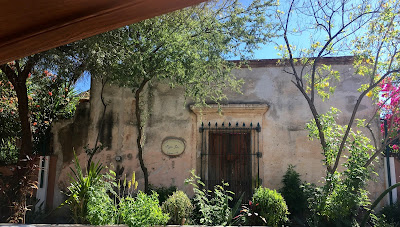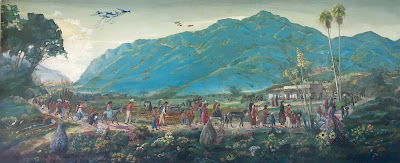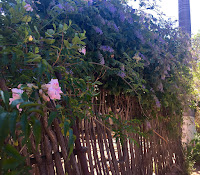A little background:
The dust had hardly settled on the battlefields of the Conquest of Mexico in 1521 when Spaniards began to extend the boundaries of their new country toward the north and west. They had noted the silver and gold ornaments the Aztecs wore and coveted the source of those precious metals. The first European to follow Indian trails through this valley was probably Diego de Guzman, hunting not only for gold and silver, but for Indians to sell as slaves. By the last quarter of the 17th century, silver mines were developing near Alamos. By the mid- 18th century, the local mines were the richest in the world. Twenty percent of the silver was sent by trains of 1,000 burros to Vera Cruz to be shipped to the King of Spain. Alamos women shopped in Paris for their velvet and silk gowns and filled their mansions with the world’s finest furnishings. Alamos supported opera and symphony, formal teas, elegant banquets, and afternoon rides in comfortable carriages. The population grew to 30,000 residents.
Then came cholera epidemics, floods, droughts, frequent attacks and plundering by Yaqui, Seri, Apache, and Pima Indians, the lengthy Mexican Revolution and political upheaval that swept wildly through Alamos. Alamenians fled, and not until the mid-20th century did Norteamericanos begin to move to Alamos to rebuild the crumbling, graceful, block-big, adobe, Colonial homes.
Now, almost 500 years since the Spaniards arrived, Alamos is a beautifully restored historic treasure, a destination for about 300 extranjeros, a thriving municipality of 10,000 supported by tourism and enterprises in agriculture and mining, this time copper as well as silver.
Every Saturday the Amigos de Education de Alamos conduct a home tour of the restored Spanish Colonial homes and gardens that are one of the city's most popular tourist attractions. The Amigos provide to economically needy and academically qualified students who live in Alamos. We felt incredibly fortunate to see three very different homes while we were there.
 |
| We drove around town in this little toy train. |
 |
| The ghosts of Alamos |
 |
| The home of a famous Mexican actress. |
The first home we visited was that of Joan Gould Winderman, an artist and former teacher. Her home was my very favorite. She was very gracious, knowledgeable and interesting. She had some beautiful art pieces throughout the house:
Her husband is no longer alive but he was the architect of the building. It was a ruin when they bought it and turned it into the magnificent property it is today.
 |
| Joan and Earle in younger days |
 |
This lovely garden room was all glass. The views were just magnificent, overlooking the mountains and the huge vegetable and flower gardens which she is constantly rehabbing. Today she boils plants from the garden to make
paper for her artistic cards made of feathers, her boiled paper and other natural objects. |
 |
The kitchen is in a space beside the garden room. It is
simply decorated with natural objects, her art collection
and even had a table set with flowers from the garden
matching the dinnerware. |
 |
There is a small palapa which features a
lovely personal area where she prefers
to sleep. The other building also has a bedroom
and living room. |
Next, we were greeted by Nicole, who, with her husband, has restored a sprawling ranch ruin.
 |
| Nicole, now |
 |
| And then |
 |
| The view into the gardens from the living area |
 |
| I loved the shell headboard, part of the wall and the simplicity of the room. |
 |
A kind of white wood in the ceilings created a wonderful,
natural feel |
 |
| Nicole's husband is a sculptor and painter. |
 |
This was a sculpture of the natural world and
the industrial one. |
 |
| I liked the simplicity of this little circular garden. |
The last house-or I should say, series of buildings, was what seemed out in the country but was actually only a few blocks from the main part of town. It was owned by Mary Jo and her husband, who was a general contractor. There was the main sleeping, eating and "being" area which was converted from the original bungalow on the property. There was a huge palapa with seating for many below and a kitchen area, lounging and fireplace upstairs. There was a garage for all this man's toys and a casita for guests. Oh, and a swimming pool and fire pit! Amazing!




































No comments:
Post a Comment